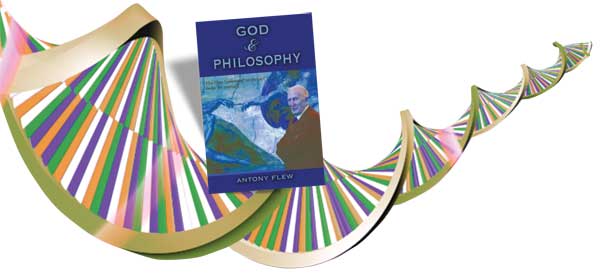At the foundation of the theory of evolution lies materialist philosophy, based on the hypothesis that nothing exists apart from matter. This theory maintains that matter has existed and will continue to exist for all time. Materialists employ a logical process known as reductionism in order to back up these claims. Reductionism is the idea that, like matter itself, invisible forces can also be explained in terms of material agents.
To clarify this, consider the example of the human mind, something that cannot be touched or seen. What is more, there is no "mind center" in the human brain, which inevitably leads to the conclusion that the mind is beyond matter. The thinking, loving, passionate rejoicing, happy or suffering entity we refer to as "me" is not a material entity in the same sense that a table or a stone is.
Materialists, however, maintain that mind can be reduced to matter. According to this claim, our thinking, loving, rejoicing and all other mental activities basically consist of chemical reactions between the atoms in our brains. Our loving someone is a chemical reaction in various cells; the way we feel fear is another such reaction. The famous materialist philosopher Karl Vogt expressed this with irrational logic: "The brain secretes thought just as the liver secretes bile."132 The fact is, however, that bile is matter, but no evidence suggests that thought is matter, too.
Reductionism follows a logical course, but logical progressions may not always be based on sound foundations. What happens when reductionism, the fundamental logic of materialism, is compared against scientific facts?
Nineteenth-century scientists and thinkers imagined that they could easily answer that question by saying, "Science confirms reductionism." However, 20th -century science has revealed that the information existing in nature can never be reduced to matter.
 You have already seen that living things' DNA contains very wide-ranging information. A literal data bank that describes all the physical details of an organism's body is squeezed into a space just 1/100,000 of a millimeter. In addition, the living cell also possesses a system that reads and interprets this information and engages in production accordingly. In every living cell, the information inside DNA is read by various enzymes, and proteins produced according to that information. Every second, the manufacture of millions of proteins, of just the type required for the site concerned, takes place inside our bodies. By means of this system, eye cells or blood cells that die are replaced by new ones.
You have already seen that living things' DNA contains very wide-ranging information. A literal data bank that describes all the physical details of an organism's body is squeezed into a space just 1/100,000 of a millimeter. In addition, the living cell also possesses a system that reads and interprets this information and engages in production accordingly. In every living cell, the information inside DNA is read by various enzymes, and proteins produced according to that information. Every second, the manufacture of millions of proteins, of just the type required for the site concerned, takes place inside our bodies. By means of this system, eye cells or blood cells that die are replaced by new ones.
Can the information inside DNA be reduced to matter, as materialists would have us believe? Or can DNA be regarded as only a collection of matter, with the information it contains emerging through random interactions of matter?
All the scientific research carried out in the 20th century, the results of all the experiments and observations, show that life definitely does not consist of matter alone. As the leading information theoretician and biophysicist Hubert Yockey puts it: "Like all messages, the life message is non-material but has an information content measurable in bits and bytes."133
The scientist Dean Overman says that "information contained in the genetic code, like all information or messages, is not made of matter . . . The meaning is not a property of the arrangement of the symbols or alphabet of the code. The message or meaning in the genetic code is non-material and cannot be reduced to a physical or chemical property."134
Prof. Phillip Johnson says:
First, life consist not just of matter (chemicals) but of matter and information. Second, information is not reducible to matter, but is a different kind of "stuff" altogether. A theory of life thus has to explain not just the origin of matter but also the independent origin of the information. Third complex, specified information of the kind found in a book or a biological cell cannot be produced either by chance or at the direction of physical and chemical laws.135
In his book In the Beginning Was Information, the information theoretician Prof. Werner Gitt also states that life cannot be reduced to matter alone:
Matter and energy are basic prerequisites for life, but they cannot be used to distinguish between living and inanimate systems. The central characteristic of all living beings is the "information" they contain, and this information regulates all life processes and procreative functions. Transfer of information plays a fundamental role in all living organisms. When, for example, insects carry pollen from one flower to another, this is in the first place an information-carrying process (genetic information is transferred); the actual material employed is of no concern. Although information is essential for life, information alone does not at all comprise a complete description of life.136
The fact that the genetic code contains non-material information shows that evolutionists' dreams regarding the genetic code are unfounded right from the outset. Their scenarios assume that matter somehow organized itself in order to give rise to the genetic code and genetic information. But since matter is unable to spontaneously produce that genetic code, all materialist explanations are totally meaningless.
Furthermore, the arrangement of the genetic letters in DNA is of vital importance for life. Nucleotides are meaningless on their own, by coming together in particular sequence, they give rise to genes that carry meaningful information that significantly distinguishes DNA from other structures seen in nature. Prof. Phillip Johnson refers to this property of DNA in these terms:
The important thing about DNA is not the chemicals but the information in the software, just as the important thing about a computer program or a book is the information content and not the physical medium in which that information is recorded. … metabolism and reproduction cannot get started until an enormous amount of complex information is already in existence.137
As Johnson states, the random combination of chemical substances cannot establish the necessary conditions for organisms to live and reproduce. Chemical substances must be assembled in such a way as to constitute the comprehensive and meaningful information in DNA. It is impossible to find such an intention in atoms and molecules. The source of this information is Omniscient and Almighty Allah, the Creator of all things on the Earth and in the sky. The well-known theoretical physicist Paul Davies describes the value of genetic information from this perspective:
... [T]he distinctive feature of biological information is that it is replete with meaning. DNA stores the instructions needed to build a functioning organism; it is a blueprint or an algorithm [a logical step-by-step procedure] for a specified, predetermined product. Snowflakes don't code for, or symbolize, anything, whereas genes most definitely do. . . It is the quality, not the mere existence, of information that is the real mystery here.138

Paul Davies refers to the origin of genetic information as a "mystery" because no materialist account for the information inside DNA can be given. Materialism has once again collapsed in the face of the fact of creation. The chemist Michael Polanyi, an eminent 20th century philosopher of science, states that there can be no materialist explanation for the transmission of the information in DNA:
The life process is essentially the development of a fertilized cell, as the result of information imparted by DNA. Transmission of this information is nonchemical and nonphysical, and is the controlling factor in the life process. The description of a living system therefore transcends the chemical and physical laws which govern its constituents.139
In "Information in the Holographic Universe" an article published in Scientific American magazine, the theoretical physicist Prof. Jacob D. Bekenstein describes the importance of information:
Ask anybody what the physical world is made of, and you are likely to be told "matter and energy." Yet if we have learned anything from engineering, biology and physics, information is just as crucial an ingredient. The robot at the automobile factory is supplied with metal and plastic but can make nothing useful without copious instructions telling it which part to weld to what and so on. A ribosome in a cell in your body is supplied with amino acid building blocks and is powered by energy released by the conversion of ATP to ADP, but it can synthesize no proteins without the information brought to it from the DNA in the cell's nucleus. Likewise, a century of developments in physics has taught us that information is a crucial player in physical systems and processes.140
When you look at evolutionist writings, you can see that they sometimes admit that their theory is at a complete impasse in the face of the information in living things. One outspoken authority on this subject is the French zoologist Pierre-Paul Grassé. Despite being a materialist and an evolutionist, Grassé admits that the most important fact to invalidate Darwinism is the information constituting life:
Any living being possesses an enormous amount of "intelligence," very much more than is necessary to build the most magnificent of cathedrals. Today, this "intelligence" is called "information," but it is still the same thing. It is not programmed as in a computer, but rather it is condensed on a molecular scale in the chromosomal DNA or in that of any other organelle in each cell. This "intelligence" is the sine qua non of life. If absent, no living being is imaginable. Where does it come from? This is a problem which concerns both biologists and philosophers and, at present, science seems incapable of solving it.141
 |
The reason why Grassé says "science seems incapable of solving it" is his unwillingness to regard any non-materialist explanation as scientific. In fact, however, that science itself refutes the assumptions of materialist philosophy and proves the existence of a Creator. Grassé and other materialist scientists close their eyes to this, or else say "Science is unable to explain." Because they are materialists first and scientists second, and they persist in believing in materialism, even if science proves the exact opposite.
This striking fact concerning DNA-the fact that genetic information cannot be accounted for in terms of matter and energy or natural laws-continues to represent an insuperable barrier in front of the theory of evolution. Prof. Werner Gitt, director of the German Federal Institute of Physics and Technology says this:
The fundamental quantity information is nonmaterial (mental) entity. It is not a property of matter, so that purely material processes are fundamentally precluded as sources of information…there is no known law of nature, no known process and no known sequence of events which can cause information to originate by itself in matter.142
In another extract, Gitt states that information can only exist by being created:
Biological information . . . has a very high storage density and that it obviously employs extremely ingenious concepts. . . .it is clear that the information present in living organisms requires an intelligent source. Man could not have been this source, so that the only remaining possibility is that there must have been a Creator.143
 |
| Among His Signs is the creation of the heavens and Earth and all the creatures He has spread about in them ... |
Gitt's words are also the conclusions reached by the Information Theory, regarded as part of thermodynamics and developed over the last 20 to 30 years. Information theory investigates the structure and origin of the information in the universe. The conclusion reached thanks to lengthy research by information theoreticians is that information is something different from matter. It can never be reduced to matter. The origins of information and matter must be investigated separately.
The origin of the information in DNA is a dilemma that materialists can never resolve. The origin of the information encoded in the DNA molecule can never be accounted for through any natural mechanism. All observations, experiments, and experience show that information can emanate only from a conscious entity. The information in DNA is the work of Almighty Allah, the Creator of all life. In the Qur'an, our Lord's creative artistry and infinite power are described in these terms:
That is Allah, your Lord. There is no deity but Him, the Creator of everything. So worship Him. He is responsible for everything. Eyesight cannot perceive Him but He perceives eyesight. He is the All-Penetrating, the All-Aware. (Surat al-An'am, 102-103)
When we apply this result revealed by science, we are confronted by a most important conclusion. Because, as in the case of DNA, nature is full of glorious information-and since this information cannot be reduced to matter-it must have a non-material source.
| This Book is More Than Just Paper and Ink |
| Like other books, this book you are reading is made up of paper and ink, which carry the information. Paper and ink are both material substances. Paper is made from cellulose, and ink from various chemicals. However, the information in this book is not physical and does not have any material origin. The source of the information in this book, as in all others, is the mind of its author. In addition, that mind also determines how the paper and ink are to be used. A book first takes shape in its author's mind. The writer established a logic and constructs sentences that are then given a material form, by using a typewriter or a computer keyboard. These letters then enter the printing press and are turned into a book consisting of paper and ink. Based on this analogy, Prof. Phillip Johnson says this about the origin of DNA: It would be absurd to try to explain the literary quality or meaning of a book as an emergent property of the physical qualities of its ink and paper. The message comes from an author; ink and paper are merely the media. Similarly, the information written in DNA is not the product of DNA. Who or what is the author?1 If a material substance contains information, then that matter has been arranged by an intellect possessing that information. In this case, that intellect belongs to our Almighty Lord, Who created the entire universe out of nothing.
 |
George C. Williams accepts this fact that most materialists and evolutionists are unwilling to see. For many years, Williams supported materialism in a most dogmatic fashion. But in an article written in 1995, he expressed the error of the materialist (reductionist) approach that assumes that everything consists of matter:
Evolutionary biologists have failed to realize that they work with two more or less incommensurable domains: that of information and that of matter. . . . These two domains will never be brought together in any kind of the sense usually implied by the term "reductionism." . . . This dearth of shared descriptors makes matter and information two separate domains of existence, which have to be discussed separately, in their own terms. The gene is a package of information, not an object. . . . In biology, when you're talking about things like genes and genotypes and gene pools, you're talking about information, not physical objective reality.144
Twentieth-century science revealed that the information in DNA cannot be reduced to matter, as materialists maintain. Therefore-and contrary to what materialists imagine-the origin of the information in nature cannot be matter itself. The source of information is not matter, but a supra-material Intelligence that existed before matter. Matter came into being, took shape and was arranged through it. That Intelligence belongs to Allah, the Lord of all the worlds. While demolishing materialist philosophy, this extraordinary information in the origin of life also provides countless proofs of the manifest existence of Allah.
| The Complex Structure in DNA Led Antony Flew To Faith |
| "As people have certainly been influenced by me, I want to try and correct the enormous damage I may have done." (Anthony Flew) In the face of the complex structure in DNA, the famous atheist Anthony Flew admitted that the atheism he had espoused for 66 years was a theory in collapse. The 81-year-old British philosopher adopted atheism at the age of 15, and first made his mark on the academic world with a paper published in 1950. Over the next 54 years, he defended atheism in debates at the universities of Oxford, Aberdeen, Keele and Reading where he taught, at a large number of Canadian and American universities he visited, and in books, classes and articles. Recently, however, Flew abandoned his error and admitted that the universe had been created. In The Sunday Times, he was quoted as saying this about the theory of evolution: I have been persuaded that it is simply out of the question that the first living matter evolved out of dead matter and then developed into an extraordinarily complicated creature.1 What influenced this radical about-face was the definitive proofs of creation revealed by modern science. In the face of the information-based complexity of life, Flew concluded that life had been consciously created, and set out the scientific causes underlying this change of belief: Biologists' investigation of DNA has shown, by the almost unbelievable complexity of the arrangements which are needed to produce [life], that intelligence must have been involved.2 The DNA research that Flew indicated was the main reason for his change of view. This research has indeed revealed striking truths about the fact of creation. The helix structure of the DNA molecule, its possession of the genetic code, the critical nucleotide sequences that refute evolution, the storage of an encyclopedic quantity of data and many more striking discoveries all revealed that the structure and functions of this molecule had been specially arranged to maintain life. The acceptance of conscious creation by this long-term advocate of atheism, reflects the process of collapse in which atheism finds itself. Modern science has revealed the existence of a Creator and thus left atheism entirely out of the question.  Prof. Gerald Schroeder, one of the scientists who influenced Flew, refers to the intellect and knowledge manifested in the entire universe in his book Science Reveals the Ultimate Truth: A single consciousness, a universal wisdom, pervades the universe. The discoveries of science, those that search the quantum nature of subatomic matter, have moved us to the brink of a startling realization: all existence is the expression of this wisdom. In the laboratories we experience it as information that first physically articulated as energy and then condensed into the form of matter. Every particle, every being, from atom to human, appears to represent a level of information, of wisdom.3 Scientific research into both the functioning of the cell and the subatomic particles of matter have revealed this in undeniable form: life and the universe were brought into being by an Almighty and Omniscient entity. No doubt, this knowledge and intellect that pervade the universe at every level are those of Almighty Allah. Allah reveals this fact in the Qur'an: Both East and West belong to Allah, so wherever you turn, the Face of Allah is there. Allah is All-Encompassing, All-Knowing. (Surat al-Baqara, 115)
|
132. Encyclopædia Britannica, "Modern Materialism"
133. Hubert Yockey, "Information in Bits and Bytes", BioEssays, 1995, Vol. 17, p. 85.
134. Dean L. Overman, A Case Against Accident and Self-Organization, Rowman & Littlefield Publishers, 1997, p. 37.
135. Phillip E. Johnson, Defeating Darwinism by Opening Minds, InterVarsity Press, Illionis, 1997, p. 75.
136. Werner Gitt, In the Beginning was Information, p. 89.
137. Phillip E. Johnson, The Wedge of Truth, p. 53.
138. Paul Davies, The Fifth Miracle: The Search for the Origin and Meaning of Life, Simon & Schuster, 1999, p. 60.
139. Michael Polanyi, "Life Transcending Physics and Chemistry", Chemical & Engineering News, Vol 45, no. 35, 21 August 1967, p. 56.
140. Jacob D. Bekenstein, "Information in the Holographic Universe", Scientific American, 14 July 2003, p. 59.
141. Pierre P. Grassé, The Evolution of Living Organisms, 1977, p. 2.
142. Werner Gitt, In the Beginning was Information, pp. 47, 107.
143. Ibid., p. 97.
144. George C. Williams, The Third Culture: Beyond the Scientific Revolution, Simon & Schuster, New York, 1995. p. 43.